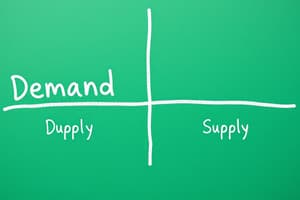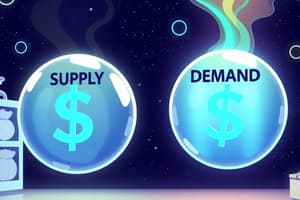Podcast
Questions and Answers
What does the price elasticity of demand measure?
What does the price elasticity of demand measure?
- The total quantity demanded at a specific price point.
- The shift in the demand curve when consumer preferences change.
- The change in price in response to a change in consumer income.
- The percentage change in quantity demanded in response to a percentage change in price, holding other factors constant. (correct)
A movement along the demand curve is caused by a change in a non-price determinant of demand.
A movement along the demand curve is caused by a change in a non-price determinant of demand.
False (B)
What is market demand?
What is market demand?
Market demand is the sum of all individual demands for a particular good or service at various prices.
When the percentage change in quantity demanded is greater than the percentage change in price, demand is considered ______.
When the percentage change in quantity demanded is greater than the percentage change in price, demand is considered ______.
Match the following terms with their correct descriptions:
Match the following terms with their correct descriptions:
Which of the following best defines 'demand' in economics?
Which of the following best defines 'demand' in economics?
An increase in consumer income will always lead to an increase in demand for all goods.
An increase in consumer income will always lead to an increase in demand for all goods.
According to the Law of Demand, what happens to the quantity demanded of a good when its price increases, all other things being equal?
According to the Law of Demand, what happens to the quantity demanded of a good when its price increases, all other things being equal?
Goods for which demand decreases when consumer income rises are called ______ goods.
Goods for which demand decreases when consumer income rises are called ______ goods.
Which of the following factors would cause a movement along the demand curve for a product?
Which of the following factors would cause a movement along the demand curve for a product?
If the price of peanut butter increases, the demand for jelly (assuming they are complements) will likely increase as well.
If the price of peanut butter increases, the demand for jelly (assuming they are complements) will likely increase as well.
Which of the following is NOT a factor that can influence demand?
Which of the following is NOT a factor that can influence demand?
Flashcards
Shift in Demand Curve
Shift in Demand Curve
Occurs when non-price determinants of demand change, resulting in a new demand curve.
Movement along Demand Curve
Movement along Demand Curve
Change in quantity demanded caused by a change in price, holding other factors constant.
Market Demand
Market Demand
The sum of all individual demands for a good or service at various prices.
Elasticity of Demand
Elasticity of Demand
Signup and view all the flashcards
Types of Elasticity
Types of Elasticity
Signup and view all the flashcards
Demand
Demand
Signup and view all the flashcards
Quantity Demanded
Quantity Demanded
Signup and view all the flashcards
Law of Demand
Law of Demand
Signup and view all the flashcards
Normal Goods
Normal Goods
Signup and view all the flashcards
Inferior Goods
Inferior Goods
Signup and view all the flashcards
Substitutes
Substitutes
Signup and view all the flashcards
Complements
Complements
Signup and view all the flashcards
Demand Curve
Demand Curve
Signup and view all the flashcards
Study Notes
Introduction to Demand
- Demand in economics represents consumer desire and ability to purchase a good or service at various prices during a specific period.
- It's a core microeconomic concept, illustrating how consumers choose based on price and other factors.
- Demand differs from quantity demanded. Quantity demanded is the amount consumers buy at a specific price; demand is the price-quantity relationship across various prices.
Factors Influencing Demand
- Price: Price and quantity demanded are inversely related (ceteris paribus). Higher prices lead to lower quantity demanded, and vice-versa. This is the law of demand.
- Consumer income: Normal goods see demand rise with income; demand for inferior goods falls with income.
- Prices of related goods:
- Substitutes: Increased price of one good leads to increased demand for its substitute. (e.g., rising coffee price boosts tea demand).
- Complements: Higher price of one good reduces demand for its complement. (e.g., rising car prices cut gasoline demand).
- Consumer tastes and preferences: Trends, popularity, and sentiment alter demand.
- Consumer expectations: Future price or income expectations affect current demand.
- Number of buyers: More consumers generally boost overall demand.
- Seasonality: Demand for certain goods varies with the season (e.g., winter coats in winter).
Demand Curve
- The demand curve visually illustrates the price-quantity demanded relationship.
- It typically slopes downward from left to right, reflecting the inverse relationship.
- A shift in the curve reveals a change in demand (factors besides price alter the price-quantity relationship).
- Movement along the curve shows quantity demanded change due to price changes, holding other factors constant.
Law of Demand
- The law of demand states that, all other factors being equal, a good's quantity demanded rises when price falls, and vice-versa.
Shifts vs. Movements along the Demand Curve
- A shift in the demand curve happens when non-price demand determinants change, creating a new curve.
- A movement along the demand curve depicts a change in quantity demanded due only to a price change, with other factors constant.
Market Demand
- Market demand is the total demand for a good or service at various prices.
- It's calculated by summing individual demand curves horizontally.
- Market demand reflects the collective consumer behavior in that market.
Elasticity of Demand
- Demand elasticity measures how responsive quantity demanded is to price changes.
- It's typically a ratio.
- Price elasticity of demand measures percentage quantity demanded change from price changes, with other factors fixed.
- Types of elasticity:
- Elastic: Percentage change in quantity demanded is greater than percentage price change.
- Inelastic: Percentage change in quantity demanded is less than percentage price change.
- Unit elastic: Percentage change in quantity demanded equals percentage price change.
Conclusion
- Demand is a key economic concept explaining consumer choices based on various factors.
- Understanding demand aids businesses in pricing, production, and market analysis.
- Demand changes due to multiple factors, analysed clearly via graphs and diagrams.
Studying That Suits You
Use AI to generate personalized quizzes and flashcards to suit your learning preferences.




